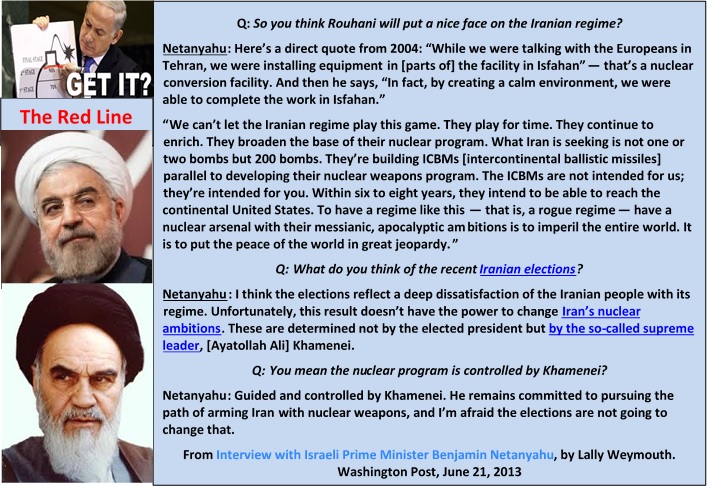Let there be no mistake, we are living in increasingly dangerous times. In particular, if Iran gets nuclear weapons that can be delivered by ballistic missile or satellite, that may very well be the spark that explodes the increasingly troubled Middle East—with Iran’s intended catastrophic consequences for the Little Satan, Israel, and the Great Satan, the United States. Concurrently, U.S. diplomatic strength is dropping to a historic low as respect for U.S. leadership ebbs throughout the world—and this makes dealing with Iran even more difficult.
The Economist’s June 22nd article “Persian Power: Can Iran be Stopped?” ponders the issues we discussed a week ago and comes out at the same place, in their words: “Hope for the best, and prepare for the worst.” I’m not sure that I concur with the Economist’s argument for greater U.S. involvement in support of the rebels in Syria or whether I’m more in agreement with Patrick Buchanan who sided with Sarah Palin: Where “both sides are slaughtering each other as they scream over an arbitrary red line ‘Allahu akbar’ … I say let Allah sort it out.” Worth your time to read Pat’s argument.
In weighing these alternatives, consider this observation from The Economist article above: “Should the West decide to use force, Iran could amass a small arsenal [of nukes] by the time support for a military strike was rallied.”
Russian Roulette.
In any case, last week’s events did nothing to strengthen U.S. equities—in particular, the President’s engagement at the G8 Economic Summit was lackluster and his speech at the Brandenburg Gate has drawn wide ridicule as being anything from meaningless “mush” to potentially dangerous—especially in his dealings with Russian President Vladimir Putin, who among other things, along with Iran, supports Assad in the Syrian conflict that has led to over 90,000 deaths.
John Bolton and Paula DeSutter notably refer to Mr. Obama’s arms control proposals as “Russian Roulette” in their June 21 Foreign Policy article—well worth your time to read. Even the Washington Post—normally an apologist for Obama policies and pronouncements—was critical of the President’s misperceptions as reflected in its June 19 editorial, which among other things noted that President Obama’s naïve portrayal of Putin as a ruler with whom he can build a constructive, cooperative relationship that moves us out of a Cold War mind-set was ”a blinkered view that willfully ignores the Russian president’s behavior.” Note the body language in the photo accompanying the Editors’ referenced article, as evidence of this alleged blooming “constructive, cooperative relationship.”
It is tempting to pile on Edelman’s and Joseph’s criticisms these criticisms of the Obama administration’s terrible strategic policy and associated arms control agenda, but I am even more concerned about a potential nearer term existential problem—one associated with a nuclear-armed Iran. Russia, of course is a key player in this concern because of its long-standing involvement with its trading partners in the Middle East. And Iran, through its surrogates, like Hezbollah, joins Russia is supporting Assad in Syria—on the other side from Obama’s feeble support to the rebels, while pressing relentlessly toward nuclear weapons.
Approaching that Red Line.
I have written about this several times before—and I am pleased that others, who have more credibility than I with the powers that be, appear to agree with many of my previous points. Perhaps the most important note of agreement with the points in last Monday’s email was provided by Lally Weymouth’s interview with Israeli Prime Minister Benjamin Netanyahu, especially the key comments repeated below, which indicate that, while Iran’s new allegedly “moderate” President, Hassan Rouhani, will take a softer tone than his bombastic predecessor, there likely will be no change in Iran’s policy and march toward nuclear weapons, as dictated by the same “Supreme Leader,” Ayatollah Khamenei. (Reading the entire interview is well worth your time.)
There also should be no difference in how Netanyahu views the “Red Line” than when he presented it to the United Nations General Assembly last September 27th. The Red Line was defined as when Iran has amassed enough uranium at 20 percent fissile purity to fuel one nuclear bomb if enriched further. Natayahu said then that Iran could reach that threshold by mid-2013.
On April 29th, Netanyahu said Iran had not yet crossed the “Red Line,” despite an assessment the preceding week to the contrary by former Israeli intelligence chief Amos Yadlin. But Netanyahu’s kinder, gentler assessment was small consolation because he added that Iran was “close” and must not be permitted to cross it. So, the mid-2013 estimate from last September may be holding—and we just passed the summer solstice. Just how long is mid-2013?
Given the loss of U.S. credibility indicated above—and considering President Obama’s half-hearted response when Syria crossed his “no use of chemical weapons Red Line,” how would you like to be in Netanyahu’s shoes contemplating Obama’s pledge to stand with Israel against Iran getting nuclear weapons? Words are cheap.
In a comprehensive June 22nd article The Economist observes that neither Iran’s election, nor sanctions nor military threats are likely to divert Iran from the path it is on to get nuclear weapons—and that Israel’s ability to deal with this imminent threat is problematic. Still, The Economist argues that Rouhani may delay the final steps, perhaps for years. (Click on the video in the above-linked quite comprehensive article for a good brief verbal discussion of these issues.)
So, what to do?
Without such a delay, Israel and the United States have a very serious problem and no good solutions—Red Line or no Red Line. Sorry about that. Optimists are talking about a containment strategy—with a theocracy dedicated to killing Israelis and Americans, and willing to commit suicide to do so? Hmmmm?
If delays occur, we will have time to prepare for Iran getting nuclear weapons and mating them to ballistic missiles to launch at Israel and America. There seems to be little debate about whether we should be prepared to defend against intercontinental ballistic missiles (ICBMs) that Iran might launch over the North Pole—only an argument about what specifically should be done beyond the current plan to buy additional ground based interceptors for our site in Alaska—and that argument seems focused on building additional ground based defense sites, on the East Coast.
Studies, expected to be mandated by the 2014 National Defense Authorization Act, should also consider how the Aegis Ballistic Missile Defense (BMD) capabilities can be included in an effective plan, which we believe is urgently needed to deal with a possible Iranian attack that may come from our South—either from a satellite borne nuclear weapon delivered over the South Pole or launched from vessels in the Gulf of Mexico. In either case, we are currently defenseless to the electromagnetic pulse (EMP) that would be generated by a nuclear detonation a couple of hundred miles above the United States, which could lead, within a year, to the death of several hundred million Americans.
We recommend efforts to network the sensors and interceptors on our existing Aegis fleet so as to provide warning and track information to enable the interception of nuclear armed satellites that approach the United States from over the South Pole. Given the approved plans for an initial Aegis Ashore site in Romania by 2015, it should be possible to deploy the first Gulf of Mexico site by that same date, or possibly sooner.
We at High Frontier will continue to inform the powers that be of this existential threat, and hopefully, key federal authorities and members of congress will soon begin to deal effectively with this existential threat. We will also be taking the message to grass roots America. Our local and state authorities need to understand these issues and what they might do if their federal representatives continue to fail “to provide for the common defense.”
And what can you do?
Join us at High Frontier in seeking to alert the public and your local and state authorities to the existential threats posed by both man-made and natural EMP events—and what can be done about these threats.
We can use your help in spreading this information to the grass roots and to encourage all “powers that be” to provide for the common defense as they are sworn to do. Will you do your part?
Begin by passing this message to your friends and suggest they visit our webpage, www.highfrontier.org for more information. Also, please encourage your sphere of influence to sign up for our weekly e-newsletter!
E-Mail Message 130624
Please click here to read Past Weekly Udpates!
Please click here to read past Flash Messages!
Please help High Frontier continue this important and timely work!
Be sure to follow us on our Social Sites!
If you found this letter via our Social Sites, and you would like to subscribe, click below!






